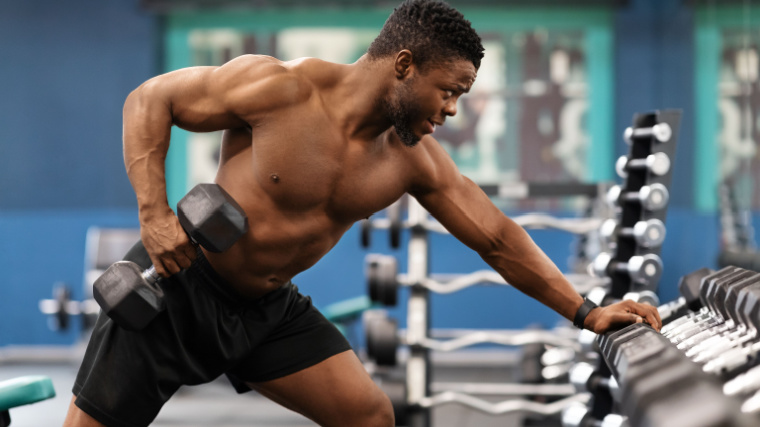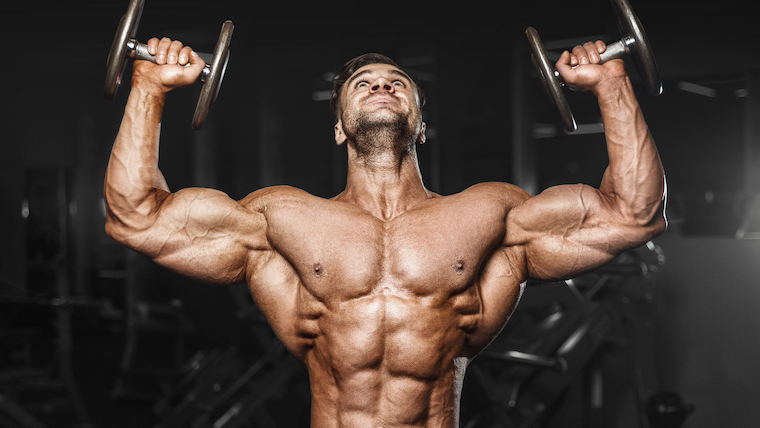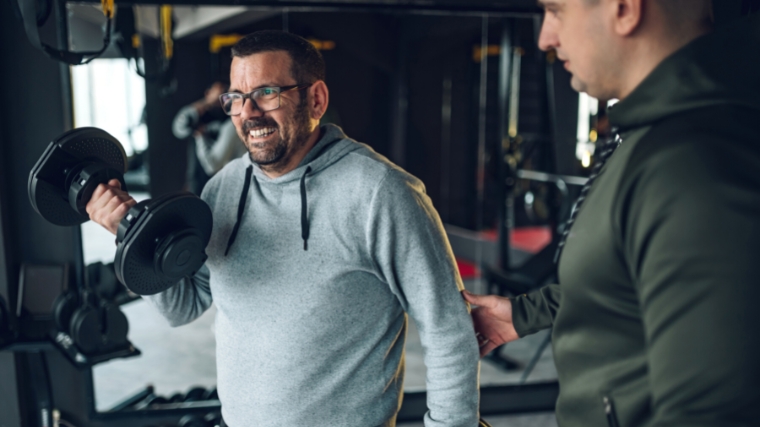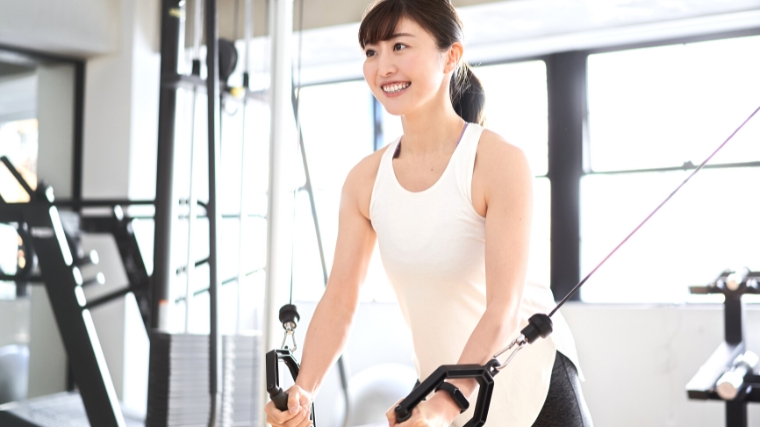Something happened. You saw Fight Club recently. Arnold Schwarzenegger’s ferocious physique in Predator struck a chord. News of Chris Bumstead’s fourth consecutive Mr. Olympia title graced your news feed. Or, perhaps, someone’s physique caught your attention while you were out running errands.
The “why” doesn’t matter — you’ve been bitten by the bodybuilding bug and you’re on the quest for muscles. Motivation is all well and good, but knowing where you want to go is only half the battle. You have to know how you’re going to get yourself there.

Luckily, you’ve found yourself in the right place. This is the best beginner bodybuilding routine on the market, tailored specifically for newcomers. Let’s get started.
Best Beginner Bodybuilding Routine
Before you dive headfirst into your basic bodybuilding training, you should have, at minimum, a general understanding of how physique enthusiasts structure their workouts. The goal of bodybuilding is to train muscles, not movements.
Bodybuilding routines are designed to induce fatigue and tissue damage that, when paired with proper nutrition and adequate recovery, leads to those muscles growing back bigger and stronger over time (a process called hypertrophy). (1)
Your best bet as a new gymgoer is to divide your training across several days, each focused on a specific set of muscles. This simple bodybuilding routine cuts your workouts into two different upper-body and lower-body-focused sessions.
Day 1 — Monday
- Back Squat or Machine Hack Squat: 3 x 6
- Dumbbell or Barbell Romanian Deadlift: 2 x 8
- Step-Up: 2 x 10
- Machine Leg Curl: 2 x 12
- Cable Crunch: 2 x 12
Coach’s Tip: Start with unweighted step-ups and then progress toward working with light weights once you can easily complete the prescribed number of reps.
Day 2 — Tuesday
- Barbell Row or Assisted Pull-Up: 3 x 8
- Close-Grip Bench Press or Dumbbell Shoulder Press: 3 x 8
- Dumbbell Pullover: 2 x 12
- Lateral Raise: 2 x 15
Coach’s Tip: If you don’t need machine assistance to perform pull-ups, work with just your body weight or hold a small dumbbell between your ankles.
Day 3 — Thursday
- Hack Squat or Leg Press: 3 x 6
- Hip Thrust: 3 x 8
- Walking Lunge: 2 x 10 steps per leg
- Leg Extension: 2 x 12
- Calf Raise: 2 x 15
[RELATED: Best Leg Exercises]
Coach’s Tip: Start with unweighted lunges and progress toward using dumbbells or a barbell once the prescribed repetitions are too easy.
Day 4 — Friday
- Lat Pulldown or Seated Cable Row: 3 x 6
- Face Pull: 2 x 12
- Dumbbell Curl: 2 x 8
- Incline Dumbbell Bench Press: 3 x 8
- Dip: 2 x 12
- Hanging Leg Raise: 2 x 15
Coach’s Tip: If bodyweight dips are too difficult, perform them using a chair or low bench, with your feet on the floor.
Note that you don’t have to perform each of these workouts on the prescribed days. As long as you separate the upper and lower-body workouts by at least 48 hours, and don’t train three or more days in a row, you can organize your beginner bodybuilding split however you like.
How to Progress Bodybuilding Workouts
Career bodybuilders and longtime gym rats scour and suffer in search of ways to make progress on their physiques. For the gym newbie, gains often come in an avalanche, especially if you eat and rest well.
However, over time, your rate of progress will begin to slow down somewhat. It helps to develop a solid understanding of progression pathways early on. That way, you can avoid plateaus and keep adding muscle to your frame.
Note that these principles are listed in their general order of importance and efficacy. When seeking out ways to progress your bodybuilding training, start at the top and work your way down:
Add Weight
For beginners, the most consistent and reliable means of ensuring muscle gain is to simply work with heavier weights over time. This is the most literal form of progressive overload; the principle that drives all resistance training programs, in one way or another.

[Read More: The Best Upper Body Exercises and Workouts]
For you, the new bodybuilder, this means trying to up your weights on at least one exercise per session or per week. Incremental increases are smarter and more sustainable than large jumps — you can slap on lots of weight regularly in the beginning, but don’t expect to be able to add 20 pounds to your bench press every single week.
Add Sets or Reps
As you acclimate to the demands of your bodybuilding workout plan, you should also expect to squeeze out more reps per set, or sets overall, on a regular basis. Increasing your training volume (the amount of challenging work you do, typically measured weekly) is a great way to drive muscle gain without having to lift heavier weights.
Contrary to what you may have heard, there’s no strength-only rep range, nor one that will only create muscle growth. As long as you work hard, any number of reps (as high as about 20) can produce hypertrophy. (2)(3)
If you can’t seem to up the weight on your squats, lunges, or biceps curls, try to eke out another rep or two instead. Once you can perform five to six reps more than originally prescribed, it’s probably time to up the weight and start again.
Reduce Rest Times
Growing muscle means working hard, and working hard means allotting yourself adequate rest during your bodybuilding session. Most bodybuilders will rest for 45 seconds to two minutes between sets of a given exercise, and about the same when moving from one lift to another.

However, you can manipulate your rest times to make a given exercise more difficult. By trimming down your rest in five to 10-second increments, you can increase the density of your training and sap your muscles of the time they need to recover fully.
Take care to not reduce rest time such that it compromises your performance, though. If you find yourself out of breath during simple, single-joint exercises, or you can’t lift as much weight because you’re still fatigued from the prior set, take the extra time you need.
Change Exercises
As a bodybuilder, you should think of exercises as tools to build muscle. Not all tools are created equal, and they don’t necessarily work well forever. There are certainly go-to exercises that you’re likely to get good results from, but nothing is strictly mandatory.
If a given exercise doesn’t produce the result you want, don’t be afraid to swap it out for a movement that better aligns with your body, as long as you can still follow the principles of progression for muscle growth.
In fact, a bodybuilding routine with large exercise variance may yield more muscle and strength gains than one that only has you perform a handful of different lifts. (4)
Focus Harder
Bodybuilding is as much (if not more) a mental game as it is a physical pursuit, especially later on in your career. When you train for muscle growth, you should go one step further than simply trying to move a weight from start to finish.

You may be able to squeeze out more gains if you take the time to mentally focus on each and every repetition and contract the target muscle as hard as you can. (5) The mind-muscle connection, as it is known, can help you better utilize different movements, especially ones that train small muscles like the biceps, triceps, or calves.
Best Gym Equipment for Bodybuilding
You shouldn’t turn a blind eye to any piece of gym equipment on your quest to build muscle. In fact, just about anything you can find in your local gym can be of use — but some implements are more useful than others.
Most bodybuilding workouts utilize a combination of free weights and machines or cables. Some exercises pair better with certain types of equipment. Here’s how it all shakes out.
Free Weights
Barbells, dumbbells, and to a lesser extent kettlebells are the backbone of most resistance training programs. Strength athletes rely almost exclusively on the barbell, while bodybuilders tend to work with dumbbells a bit more often (though this isn’t a hard-and-fast rule).
Free weights allow you to focus on the meat and potatoes of progressive overload; slowly adding weight to an exercise over time. They’re also great for performing compound movements like squats, pulls, or presses that engage many different muscle groups at once.
Machines
Weight machines may occupy the majority of floor space in most gyms, but they certainly justify their existence to the bodybuilder. Machines remove the need to stabilize the weight in space and place the exercise “on rails,” literally.
This allows you to focus entirely on contracting your muscles as hard as possible, without having to devote time or energy to stabilization, bracing, or balance. They may lack the overall stimulation of free weights, but machines allow you to take your muscles to true failure safely.
Cables
You can think of cables as the midpoint between the uninhibited motion of free weights and the consistency and safety of machines. The biggest benefit of cable stations is that they apply near-constant tension to the muscle while you lift.

Free-weight training suffers from the inconsistency of gravity. If you’re not moving the weight straight up and down, the exercise won’t challenge your muscles equally from start to finish. Cables let you circumvent this issue, making them indispensable for the bodybuilder. Use cables to hammer isolation exercises and target specific muscles.
A Word on Bodyweight Exercises
If you’re getting started on your bodybuilding journey, you may have already dabbled in some bodyweight training while you seek out the right gym routine. Push-ups, pull-ups, and other calisthenics movements can be quite effective for new lifters, but only for a limited time.
The weight of your own body can be quite challenging to work with if you’re not used to exercise. However, you’ll find that they may also become easy for you in just a few weeks of dedicated practice. There’s absolutely nothing wrong with using push-ups to build up your chest early on, but you’ll probably have to switch to weight-based movements sooner rather than later.
Once you can perform 20 or 30 unweighted push-ups or comfortably hold a plank for several minutes, these movements have mostly exhausted their usefulness.
Your Takeaways
Building muscle isn’t complicated, but that doesn’t mean it’s easy. To make gains that last, you need the right routine in your pocket.
- Muscle growth, or hypertrophy, is caused by applying mechanical tension to your body via resistance exercises.
- Bodybuilders work with a combination of free weights, machines, cables, and occasionally their own bodyweight to stimulate their muscles for growth.
- As a beginner, you can gain muscle by using a simple four-day “split” that divides your major muscle groups into short, manageable workouts.
- Ensure you’re making progress by working hard. Try to add weight, reps, or complete your workout slightly faster on a week-to-week basis.
Nutrition and recovery are also essential to healthy, sustainable training and putting on muscle. If you need to brush up on how to eat properly and rebound from your workouts, your next read is right here:
- Nutrition for Athletes: How to Eat for Muscle and Performance
- The Definitive Guide to Bodybuilding Meal Prep
- Five Tips to Improve Your Recovery Between Intense Workouts
Muscle Made Easy
No matter what got you interested in bodybuilding in the first place, the most important thing you can do is take your first steps — properly. When you’re new to weight training for muscle, just about anything will work.
The difference between a good physique and a great one depends on finding what works well. With this routine in your pocket, you have everything you need to get started making muscle.
References
- Schoenfeld B. J. (2010). The mechanisms of muscle hypertrophy and their application to resistance training. Journal of strength and conditioning research, 24(10), 2857–2872.
- Schoenfeld, B. J., Grgic, J., Van Every, D. W., & Plotkin, D. L. (2021). Loading Recommendations for Muscle Strength, Hypertrophy, and Local Endurance: A Re-Examination of the Repetition Continuum. Sports (Basel, Switzerland), 9(2), 32.
- Schoenfeld, B. J., Grgic, J., Ogborn, D., & Krieger, J. W. (2017). Strength and Hypertrophy Adaptations Between Low- vs. High-Load Resistance Training: A Systematic Review and Meta-analysis. Journal of strength and conditioning research, 31(12), 3508–3523.
- Fonseca, R. M., Roschel, H., Tricoli, V., de Souza, E. O., Wilson, J. M., Laurentino, G. C., Aihara, A. Y., de Souza Leão, A. R., & Ugrinowitsch, C. (2014). Changes in exercises are more effective than in loading schemes to improve muscle strength. Journal of strength and conditioning research, 28(11), 3085–3092.
- Schoenfeld, B. J., Vigotsky, A., Contreras, B., Golden, S., Alto, A., Larson, R., Winkelman, N., & Paoli, A. (2018). Differential effects of attentional focus strategies during long-term resistance training. European journal of sport science, 18(5), 705–712.
Featured Image: Prostock-studio / Shutterstock